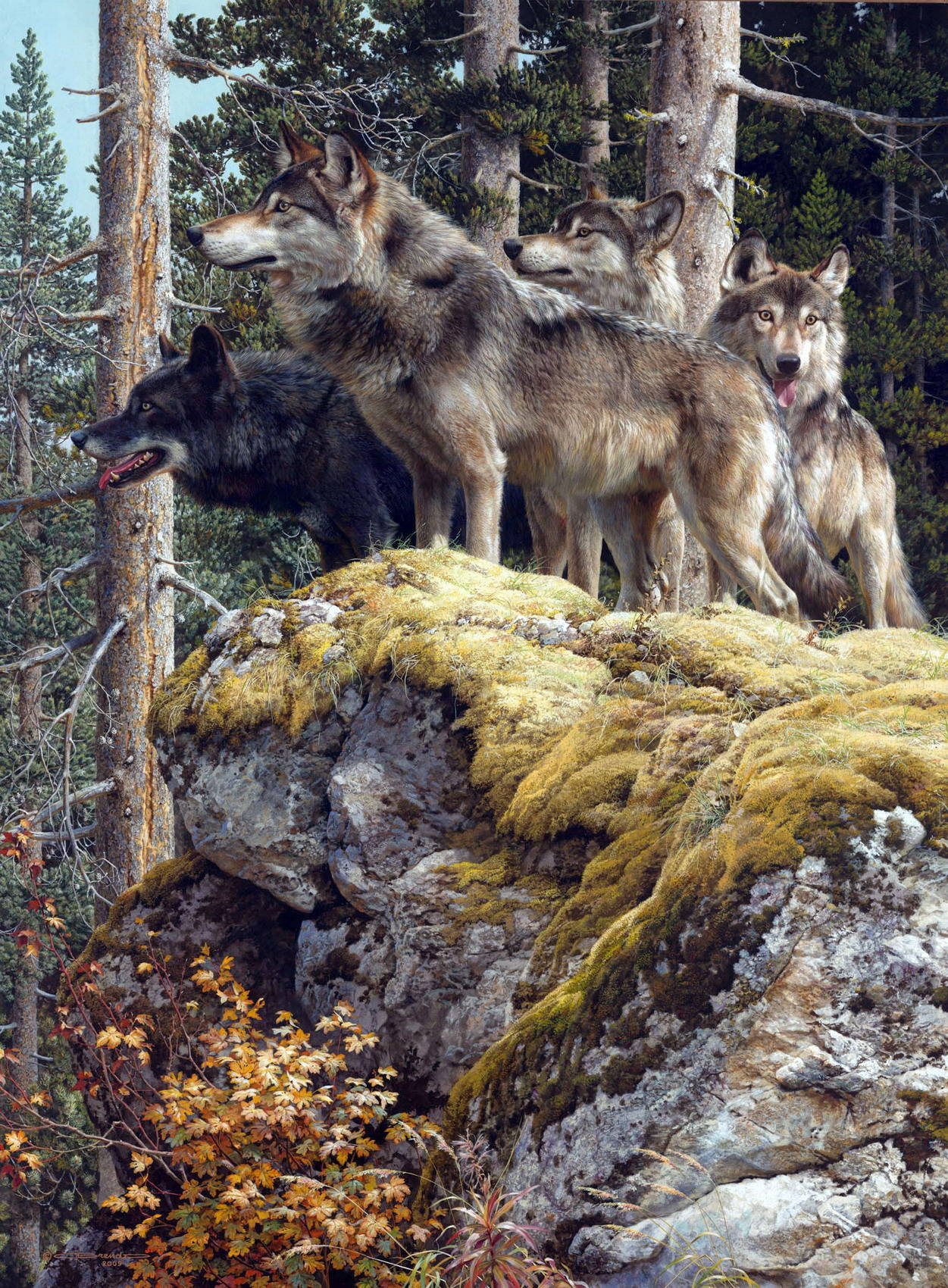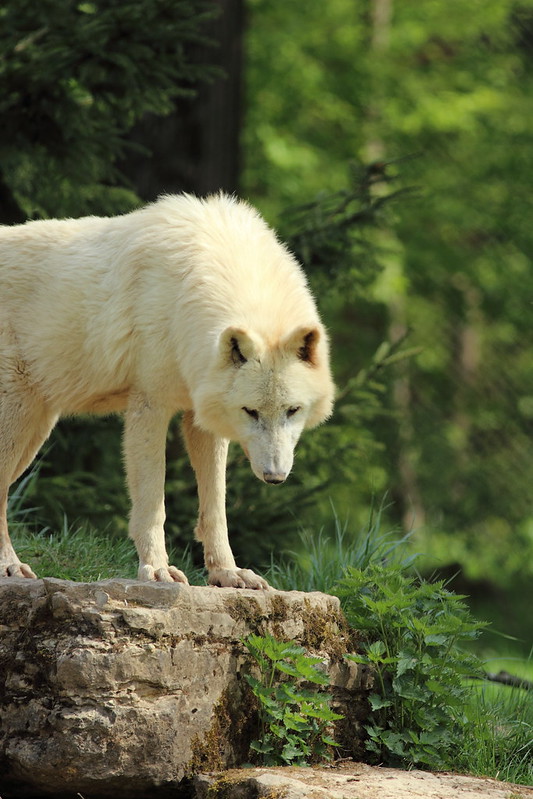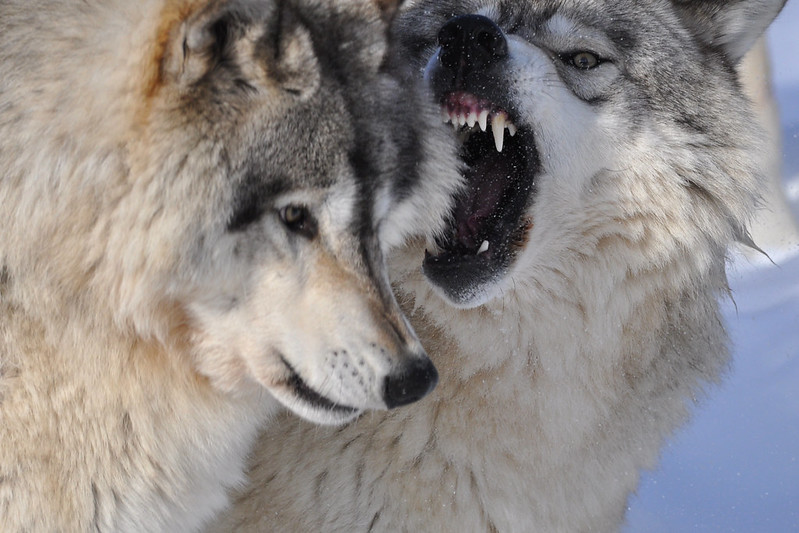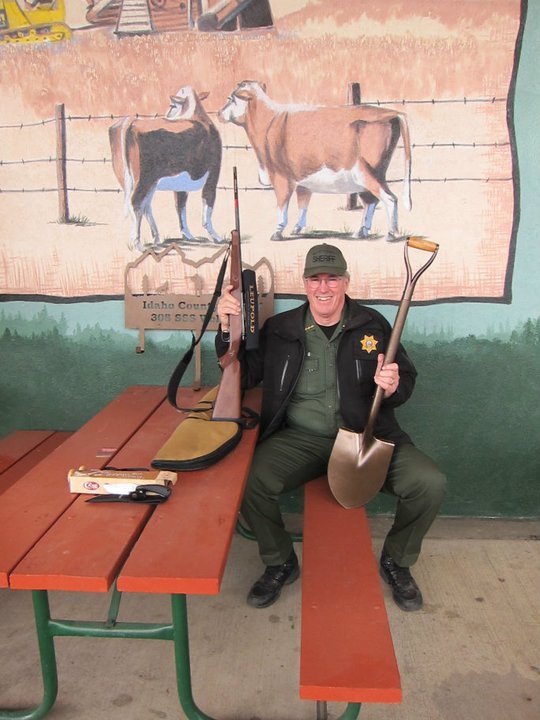As the predators dwindle, experts debate whether to intervene.

The number of wolves on Isle Royale National Park (pictured, an animal in 2008) have dwindled to just nine animals. PHOTOGRAPH BY ROLF O. PETERSON
Christine Dell'Amore
National Geographic
Published April 27, 2014
The call of the wild in northern Michigan's Isle Royale National Park may be losing one of its voices: that of the gray wolf. In 2009, scientists documented about 24 wolves living on this remote, forested island in Lake Superior (
map). But as of February 2014, that population has dwindled to nine—the second lowest total ever recorded, according to the
Wolves & Moose of Isle Royale Project, which calls itself the longest continuous study of a predator-prey system in the world.
The reason for the decline is likely inbreeding. Because
there's so little genetic diversity among the remaining wolves, all the
animals have skeletal deformities, and their weakened state could be
interfering with reproduction: Only three pups were born in 2013.
Scientists say inbreeding has become more of an issue
because the ice bridge that often connected mainland Ontario, Canada,
and Isle Royale in the winter no longer predictably forms, due to
steadily rising temperatures in the region. So wolves from Canada are
rarely able to cross the bridge and bring new genes to the existing
pack. (Last year's unusually cold winter did produce an ice bridge, and
one wolf that left the island was shot by a hunter on the mainland.)
The changed landscape presents scientists with a dilemma.
Should they intervene to save Isle Royale's wolves, or let nature take
its course?
Wolves are relatively recent arrivals to the island, which
has hosted a changing constellation of wildlife over the centuries. The
populations of beaver,
moose,
fox, and other animals there are constantly shifting. And although
wolves are considered endangered in other parts of the country, they
aren't in Michigan. (Read
"Wolf Wars" in
National Geographic magazine.)
On
April 9, the U.S. National Park Service made its stance clear: The agency will not take any immediate action to bring wolves to the island. "We think there's enough issues and questions that are
unanswered that we need to take a much closer look at it," Isle Royale
National Park Superintendent Phyllis Green told National Geographic.
The park came to its conclusion after reviewing the best
available science and the benefits to the public, Green said. "In
reality what we come back to is finding the right juxtaposition between
law, science, and the long-term stewardship of the island." (See:
National Geographic's profile on Isle Royale.)
The Park Service decision doesn't sit well with some scientists, including
Rolf Peterson,
a wildlife ecologist at Michigan Technological University in Houghton
who began leading the Isle Royale wolf-and-moose study in the 1970s.
The common notion that we should "let nature take care of
herself and not be meddling presumes that Mother Nature is intact,"
Peterson said. "But we started cutting off her fingers some time ago."

A pack of wolves travel Isle Royale National Park, which is located in Lake Superior, in 2005.
Photograph by Rolf Peterson
Genetic Rescue
Instead of taking a hands-off approach, Peterson believes
that a few wolves from the mainland should be released on Isle Royale—a
strategy called genetic rescue.
Wolves first showed up on Isle Royale in the 1940s, when a
handful crossed the ice bridge from Ontario just a few decades after
moose had made the same trek. The research study examining the
relationship between predator and prey began in 1959. (Watch
video: "Wolf Hunting Tactics.")
The research found that when new wolves crossed the ice
bridge and joined the existing population, their fresh DNA invigorated
the packs, leading to a healthier ecosystem, Peterson said.
When a new wolf appeared in 1997, for instance, the
rejuvenated population hunted more moose in the following decade than
ever before. Now the wolves are hunting very few moose, and with fewer
predators, the moose population has doubled in the past three years, to
more than 970.
The antlered herbivores are poised to quickly eat through
the 206-square-mile (534-square-kilometer) island's balsam fir and other
vegetation, presenting yet another problem for scientists. "There's a mythical belief that Isle Royale has been working well
because we kept our hands off it," Peterson said. "In my opinion, it
worked well because there were wolves there."

A wolf inspects the carcass of a moose—one of its main sources of prey—on Isle Royale National Park in 2009. Photograph by Rolf Peterson
Inbreeding Overblown?
Yet
L. David Mech,
a senior research scientist with the U.S. Geological Survey who
conducted the first three years of the Isle Royale study, argues that
the population may not be as badly affected by inbreeding as Peterson
asserts. He said there's no proof that inbreeding has affected the
ability of the wolves to survive, pointing out that they did produce
pups in 2013 and are still killing moose, albeit fewer. "I had argued it's always been inbred," said Mech, because the
original population "was founded by one female and one or two males."
What's more, the global trend of
climate change brings with it unpredictable extremes, such as more severe storms, that could create longer lasting ice bridges. (Related: "
New Climate Change Report Warns of Dire Consequences.") "That makes me more inclined to continue to say, Let's just watch the situation and see what happens," Mech said. He also believes the scientific knowledge gained by
observing the events on Isle Royale is extremely valuable and that
intervention "corrupts the value of the whole study."
For instance, he said, if scientists had intervened and
introduced wolves in 2013, "we wouldn't know if the animals that are
left could reproduce." The new pups that year proved that they could.
Richard Thiel,
a retired wolf expert at the Wisconsin Department of Natural Resources,
said he's on the fence about whether to introduce wolves to Isle
Royale. But he does see value in what he calls Mech's "argument for
letting the system go." If wolves did become extinct, he said, "it
would be interesting to see in X amount of years what happens to that
system."
Thiel noted that though the Park Service has historically
adopted a wait-and-see management approach, the agency has made bold
decisions to reintroduce animals before, including wolves to
Yellowstone National Park, starting in 1995, and black-footed ferrets to Badlands National Park, also in the 1990s. (See:
pictures of wolves in and around Yellowstone.)
Whether that was a success depends on whom you ask. The
Yellowstone environment is undoubtedly more robust, but wolves that
leave the park are often killed by hunters or ranchers, Thiel said.
That's "part of beauty of NPS properties and part of the bane: How do we
manage these ecosystems, and what should be in them?"
"it's important to hear [from] the full range of folks—there can be a lot of passion when you hear about wolves," Green said.

A wolf crosses a snowy plain on Isle Royale in 2010. Photograph by Rolf Peterson
Inevitable Extinction?
The experts differ as to whether the wolves will survive if
left alone. Mech believes they might. Thiel said he's "losing faith
that there's long-term resilience in there." He said, "Small populations such as this simply can't beat the odds,"
Mike Phillips,
who was a field biologist on Isle Royale in the 1980s and is now
executive director of the Turner Endangered Species Fund, went further,
saying that the wolves' "extinction is inevitable—it's only a question
of when."
Not only are the animals inbred and marooned without
regular ice bridges, he said, but fragmented populations of animals are
also generally more prone to go extinct. Phillips described what might be a sort of win-win
situation for the park: Let the current group of wolves die out, for the
benefit of science, and then immediately restock the island with wolves
from the mainland, so that the ecosystem can bounce back. "The [National Park Service] could stop the drama by
issuing one statement: 'We will promote studies through extinction and
shortly thereafter reintroduce wolves,'" he said.
The agency did say in its April 9 statement that "if the
island population of wolves declines to all males or all females, and if
the moose population grows to overbrowse island vegetation, bringing
wolves to the island remains an option."
Phillips is convinced that "a lot of good science" could
come from boosting the population with more wolves and "monitoring to
see how new genes can be used to bring vigor to the population." Such observations could also have global import: Many
species are becoming smaller and more isolated due to climate change and
human disturbance. The fate of the Isle Royale wolves could "give us an
idea of what populations around the world are headed for," Phillips
said.
Wisconsin's Thiel agreed: "We can watch them blink out, and
reconstruct that whole thing, and use [it] as a predictive tool for
other places where species are having trouble." Complicating the debate, he said, is the fact that nature
itself is never static, so it's difficult to say that wolves should be
on the island. "We know in our heart of hearts that natural ecosystems are always changing," he said. "The ideal state is in itself elusive."
Unique Place
One thread seems to unites all of the people who've worked
on Isle Royale: Their love of a unique, uninhabited park, one that's
hard to access but that gives visitors an unsullied wilderness
experience. "One of the draws of Isle Royale has been that there are
wolves there," said Thiel. "It's so fascinating to walk through an area
that's not touched by humans. You can't find any place like that in
North America, even in Yellowstone."
He added, "If you're lucky, you roll over in your sleeping bag in the middle of the night and hear the wolves howling." (See "
Wolves Identified by Unique Howls, May Help Rare Species.")
How long that will remain possible is unclear.































